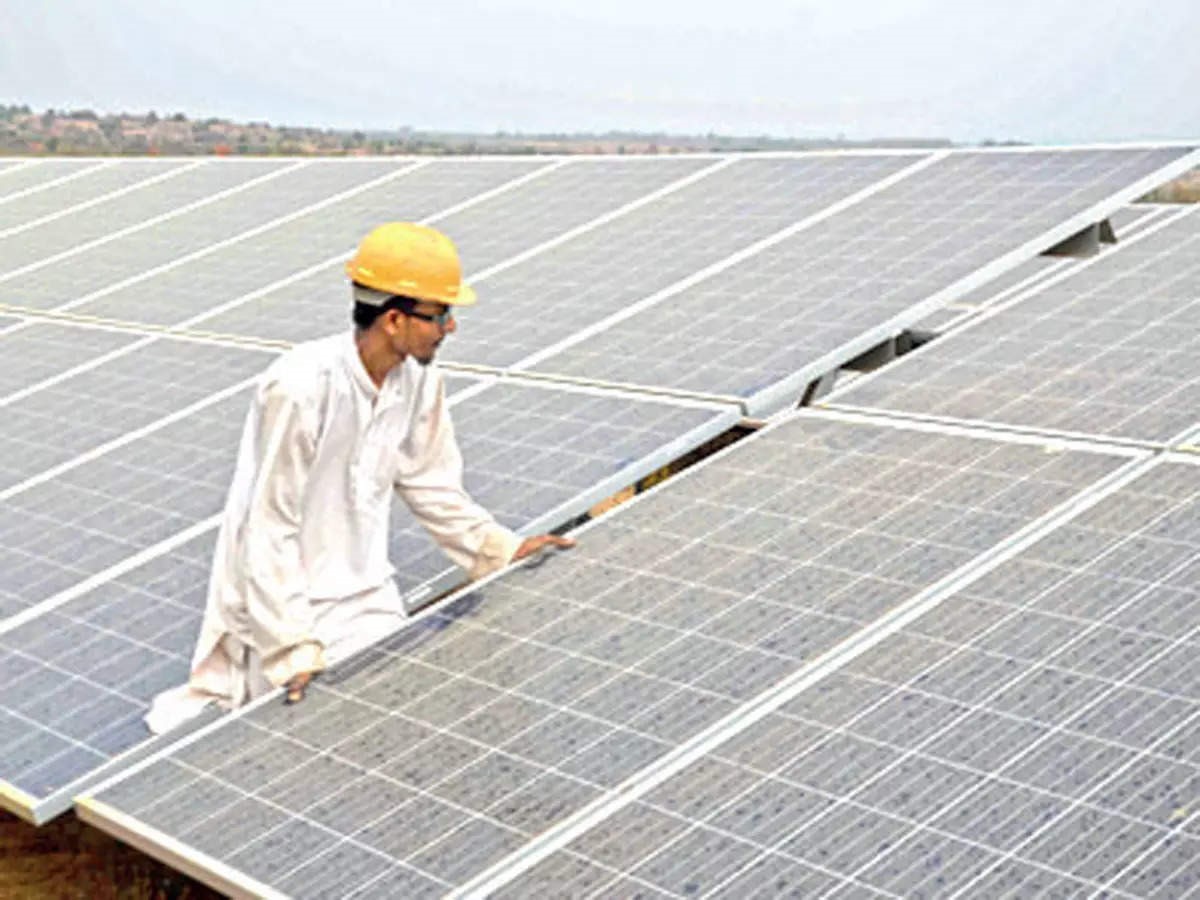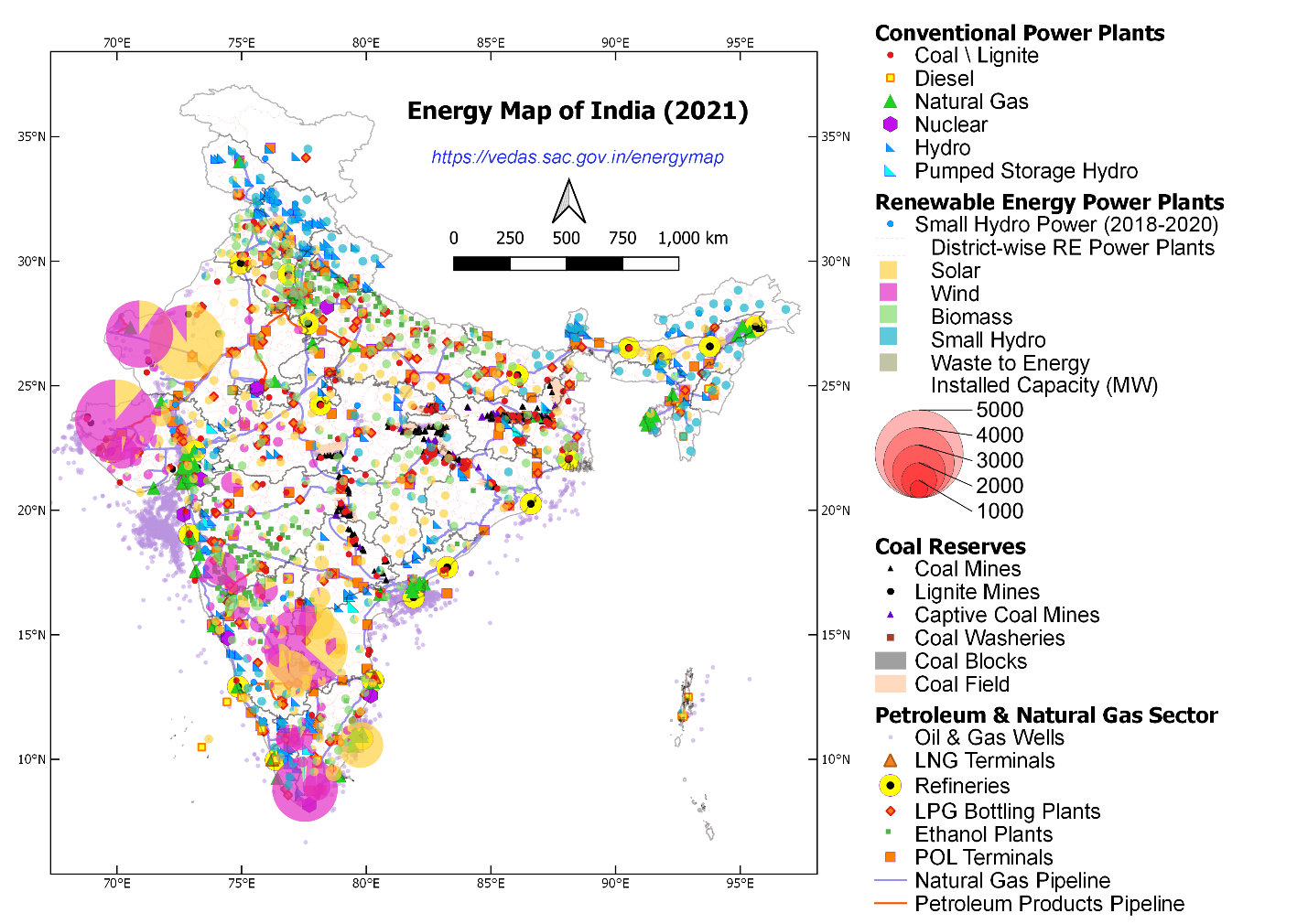Tuesday, 26th October 2021
Production Gap report, 2021
In News
The United Nations Environment Program (UNEP) has released the “Production Gap Report, 2021” to take stock of future fossil fuel use planning by Governments.
About the News
- Origins: The Production Gap Report — first launched in 2019 — tracks the discrepancy between governments’ planned fossil fuel production and global production levels consistent with limiting warming to 1.5°C or 2°C.
- Tracking of Targets: The report also tracks how governments worldwide are supporting fossil fuel production through their policies, investments, and other measures.
- 2021 report: This year’s report presents the first comprehensive update of the production gap analysis since our 2019 assessment.
- It also features individual country profiles for 15 major fossil fuel-producing countries and a special chapter on the role of transparency in helping to address the production gap.
- The Gaps: Globally the production gap is the widest for coal (240%), followed by Gas (71%) and oil (57%), in 2030.
India’s contribution to the gap is substantial.
- Gap in NDCs: India’s first NDC, issued in 2016, and pledged a 33%–35% reduction in the “emissions intensity” of its economy by 2030, compared to 2005 levels.
- However, between 2019 to 2024, India plans to expand coal production by 60% and oil and gas production by 40%.
- Coal rebate: To boost stagnant economy in times of pandemic, India provided a 50% rebate on revenue payable by coal extraction projects and committed INR 500 billion for coal extraction infrastructure.
Key Findings of the Report

What needs to be done to eliminate or reduce the Gap?
- Fossil Fuel Production: Global fossil fuel production must start declining immediately and steeply to be consistent with limiting long-term warming to 1.5°C.
- If carbon dioxide removal technologies fail to develop at large scale the production gap would be wider than estimated here.
- Role of Governments: Governments have a primary role to play in closing the production gap and in ensuring that the transition away from fossil fuels is just and equitable.
- Transparency: To increase transparency, governments could also include production plans and projections, in addition to emission goals, — and how these plans align with climate goals — in their Intended Nationally Determined Contributions (INDCs).
Sources:
GM Rice
In News
Recently, 500 tonnes of genetically modified (GM) rice was discovered in a consignment that India exported to the European Union countries in June 2021.
About the News
- Several batches of rice flour were recalled for use in the EU after European Commission Rapid Alert System for Food and Feed (RASFF) identified illegalities in food products upon a check.
- India does not permit the commercial cultivation of GM rice, but research groups are testing varieties of such rice in trial plots.
- So the suspicion is that rice from some of these test-plots may have “leaked” into the exported product.
- The Indian government has denied this possibility. However, India has indicated that it will commission an investigation involving its scientific bodies.
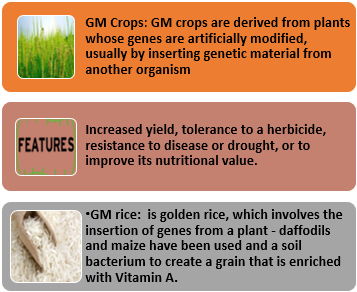
India’s Status in Rice Export
- Exports: India is the world’s top rice exporter and a leader in GM free organic rice, about a quarter of which is premium basmati.
- Imports: West Asian nations, the U.S., U.K., and the European Union are the biggest importers of basmati rice. The European Union does not permit use of GM rice in its food products.
- Impact: This incident shall lead to loss of reputation of India and its agricultural market.
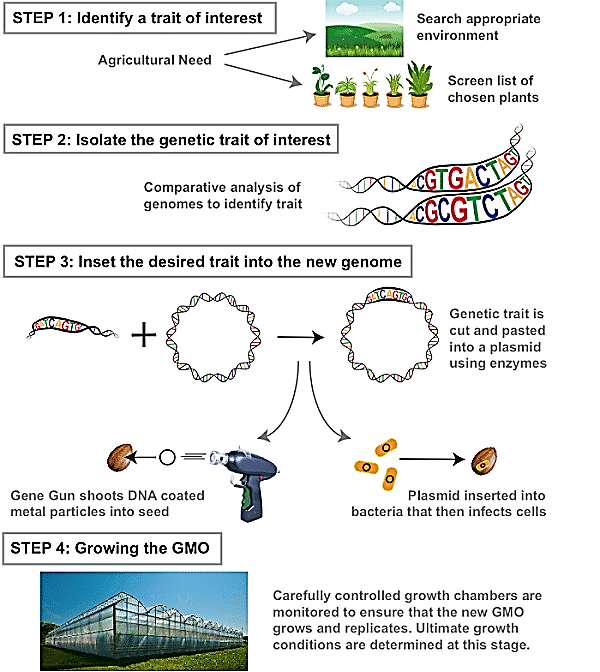
Status of GM Crops in India
- Definition: GM foods are derived from plants whose genes are artificially modified, usually by inserting genetic material from another organism, in order to give it a new property, such as increased yield, tolerance to a herbicide, resistance to disease or drought, or to improve its nutritional value.
- Probably the best known variety of GM rice is golden rice, which involves the insertion of genes from a plant -- both daffodils and maize have been used -- and a soil bacterium to create a grain that is enriched with Vitamin A.
- Approved GM Crop: India has approved commercial cultivation of only one GM crop, Bt cotton.
- No GM food crop has ever been approved for commercial cultivation in the country.
- Confined field trials: It has been allowed for at least 20 GM crops. That includes varieties of GM rice. Farm and environmental activists allege that plants or seeds from the GM rice field trials could have contaminated non-GM crops.
Way Forward
- The regulatory regime under GEAC (Genetic Engineering Appraisal Committee) needs to be strengthened, for the sake of domestic as well as export consumers.
- Technology approvals must be streamlined, and rigorous monitoring is needed to ensure that safety protocols are followed strictly, and enforcement must be taken seriously to prevent the spread of illegal GM crops.
Sources:
New Regulatory framework for NBFCs
In News
The RBI has introduced a revised scale-based regulatory framework for non-banking financial companies (NBFCs), which will be effective from 1 October, 2022.
About the News
- Reason for new regulation: RBI’s key focus for announcing a new set of regulations is to forestall and resolve the collapse of the sector as it poses a threat to the stability of the financial system. Eg. failure of IL&FS and DHFL.
- Importance of NBFCs: NBFCs are the largest net borrowers of funds from the financial system, and bank provide a substantial part of the funding to NBFCs and housing finance companies.
- According to experts, failure of any large NBFC or HFC may translate into a risk to its lenders, with the potential to create a contagion.
Key Highlights of the Framework
- Facets of Regulation: The scale-based framework encompasses different facets of regulation of NBFCs that include capital requirements, governance standards, prudential regulation etc.
- Layers in the Regulatory structure: The regulatory structure for NBFCs will comprise of four layers based on their size, activity, and perceived riskiness, named base, middle, upper and top layer.
- The top ten eligible NBFCs in terms of their asset size will always occupy the upper layer, irrespective of any other factor.
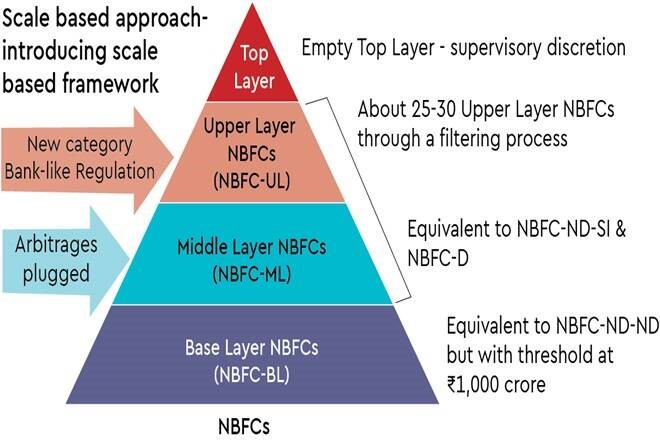
- Top Layer: This layer will remain empty. NBFCs in the upper layer may be moved to the top layer if the potential systemic risk from specific companies rises, according to the RBI's assessment.
- NPA Asset Classification: The RBI has also introduced a glide path for a minimum number of days before an account is recognised as a non-performing asset (NPA).
- The non-performing asset (NPA) classification has been changed to an overdue period of more than 90 days for all categories of NBFCs.
- Ceiling on IPO financing: There will be a ceiling of ₹1 crore per borrower for financing subscription to Initial Public Offer (IPO).
- Sensitive Sector Exposure (SSE) Norms: The RBI has proposed SSE norms for NBFCs in the middle and upper layers. NBFCs shall fix board-approved internal limits for SSE separately for capital market and commercial real estate exposures.
- Capital market, real estate and commodities have been categorized as sensitive sectors by the RBI as the prices of these assets are prone to fluctuations that may pose a risk to financial stability.
- Board member Experience: It was also decided that when it comes to the experience of the Board, considering the need for professional experience in managing the affairs of NBFCs, at least one of the directors must have relevant experience of having worked in a bank/ NBFC.
Source:
- RBI announces scale-based regulatory framework for NBFCs
- RBI caps IPO funding by NBFCs at Rs 1 cr per borrower
Image Source:
Clean Environment as Human Right
In News
Recently, the United Nations Human Rights Council (HRC) recognised for the first time that having a clean, healthy and sustainable environment is a Human right.
About the News
- The Human Rights Council passed the clean-environment resolution, which also calls on countries to boost their abilities to improve the environment. Four member states — China, India, Japan and Russia — abstained.
- A special rapporteur post has been created who will monitor how the adverse effects of climate change, including sudden and slow onset disasters, affect the full and effective enjoyment of human rights.
- In 1972, the United Nations Conference on the Environment in Stockholm, which ended with a historical declaration, was the first one to place environmental issues at the forefront of international concerns.
- It marked the start of a dialogue between industrialized and developing countries on the link between economic growth, the pollution of the air, water and the ocean, and the well-being of people around the world.
What is a Human right?
Human rights are standards that recognize and protect the dignity of all human beings. Human rights govern how individual human beings live in society and with each other, as well as their relationship with the State and the obligations that the State have towards them.
Characteristics of a Human Right
- Universality and inalienability: All people everywhere in the world are entitled to them. No one can voluntarily give them up. Nor can others take them away from him or her.
- Indivisibility: Human rights are indivisible. Whether civil, political, economic, social or cultural in nature, they are all inherent to the dignity of every human person
- Inter-dependence and inter-relatedness: The realization of one right often depends, wholly or in part, upon the realization of others. For instance, the realization of the right to health may depend on the realization of the right to education or of the right to information.
- Equality and non-discrimination: All human beings are entitled to their human rights without discrimination of any kind, such as race, color, sex, ethnicity, age, language, religion, political or other opinion, national or social origin, disability, property, birth or other status.
- Participation and inclusion: Every person is entitled to active, free and meaningful participation in, contribution to, and enjoyment of civil, political, economic, social and cultural development, through which human rights and fundamental freedoms can be realized.
- Accountability and rule of law: States and other duty-bearers must comply with the legal norms and standards enshrined in human rights instruments.
Need for Clean environment as Human right
- Accelerating Climate Change: As the world urbanizes and industrializes, and as effects of climate change intensify, environmental crises will increasingly devastate the lives, health, and livelihoods. A lack of legal regulation and enforcement can lead to a host of human rights violations.
- Cascading Effects of Environmental degradation: Biodiversity loss compromises the nutritional value of food. Today, nearly one in three people suffer from some form of malnutrition.
- The destruction of wild spaces facilitates the emergence of zoonotic diseases, Eg. Covid-19. Biodiversity loss also reduces the scope and efficacy of medicines.
- Need to protect the Vulnerable: The primary victims of environmental harm are often impoverished and marginalized communities with limited opportunity to meaningfully participate in decision-making and public debate on environmental issues, and have little access to independent courts to achieve accountability and redress.
- A Trans-boundary Issue: Many environmental problems involve transboundary harm. One country‟s pollution can become another country‟s environmental and human rights problem, particularly where the polluting media, like air and water, are capable of easily crossing boundaries.
What does Clean and Healthy Environment as Human Right mean for the world?
A clean environment is one that is void of any form of pollution and its effect. Clean environment as Human right implies that a safe, clean, healthy and sustainable environment is critical to the enjoyment of all human rights.
- Support to Environment Saving Efforts: The recognition of the right to a healthy environment at the global level will support efforts to address environmental crises in a more coordinated, effective and non-discriminatory manner, help achieve the SDGS, provide stronger protection of rights and of the people defending the environment, and help create a world where people can live in harmony with nature.
- Empower Communities: Global recognition of this right will help empower local communities to defend their livelihoods, health, and culture against environmental destruction, and help governments develop stronger and more coherent environmental protection laws and policies.
- Framing of Policies: This resolution will help adopt policies for the enjoyment of the right to a safe, clean, healthy and sustainable environment as appropriate.
- Climate Justice: This resolution is an important step to recognising the worsening impact of pollution. It will be an important tool for bringing about climate justice: pollution, especially air pollution, affects low and middle income countries most severely.
- Reduce Inequalities: The endeavours towards the recognition and implementation of the right to a healthy environment may contribute to reduce inequalities and protect the right of all human beings -irrespective of socio-economic conditions- to a healthy environment.
- Influence Climate Negotiations: The newly declared right to a healthy and clean environment will also hopefully influence positively negotiations during the upcoming UN Climate Conference COP26, in Glasgow, which has been described by the UN chief as the last chance to ‘turn the tide’ and end the war on our planet.
What will be the challenges to make the right work?
- Not legally binding: This resolution is not legally binding, meaning that there will not be immediate consequences for breaching this resolution.
- Co-ordination Problem: There can be problems with the co-ordination of international organs national legislation. Each nation has its policies and constraints that may not match with this resolution.
- Economic and Ethical Issues: Many countries lack the financial prowess to implement laws and programmes to enforce this human right to clean environment. There is a dilemma whether to invest to eradicate poverty or to take strict environment measures.
- For enforcing this Human right, the investments in renewable energy, sustainable policies, environment friendly products etc. is huge.
Way Forward
- Translating resolution into Action: The next step will be how we translate that on the right to clean air and whether we can push, for instance, for the recognition of WHO’S Global Air Quality Guidelines and the levels of exposure to certain pollutants at a country level. It will also help us to move certain legislation and standards at the national level.
- Investments in Clean Energy: All the investments need to be on ensuring access to safe water and sanitation, on making sure that electrification is done with renewable energy and that our food systems are sustainable.
- Role of Nations: States must adopt – and adhere to - ambitious, holistic policies and measures to preserve the environment and biodiversity. In doing so, they should pay extra attention to protect the rights of those most vulnerable, including children, the poor and marginalised communities who tend to be disproportionally affected by environmental degradation.
Question: What is Human right to clean environment? Discuss how this new human right will get reflected in the in different aspects of the world.
Sources:
- UN rights body: Right to clean environment is a human right
- Environment
- What are human rights?
- The right to a clean and healthy environment: 6 things you need to know
- The human right to a safe, clean, healthy and sustainable environment
- Access to a clean environment is a human right, declares the UN
- Human Rights and Environment
- Report of the Independent Expert on the issue of human rights obligations relating to the enjoyment of a safe, clean, healthy and sustainable environment, John H. Knox
- TWO MAJOR CHALLENGES OF OUR TIME: HUMAN RIGHTS AND THE ENVIRONMENT"
- Living in a clean environment: a neglected human rights concern for all of us
This Day in History - Instrument of Accession
On October 26, 1947 Maharaja Hari Singh of Jammu & Kashmir signed the Instrument of Accession in the midst of a tribal invasion supported by Pakistan. Both India and Pakistan were angling to assimilate Jammu and Kashmir into their respective territories, but Maharaja Hari Singh, the Hindu ruler of the Muslim-majority princely state, was not committing to either side. At the same time, there were anti-Maharaja protests, primarily in Poonch and Srinagar. The Instrument of Accession guaranteed limited access to India in Jammu and Kashmir—on matters of defence, communications and foreign affairs.
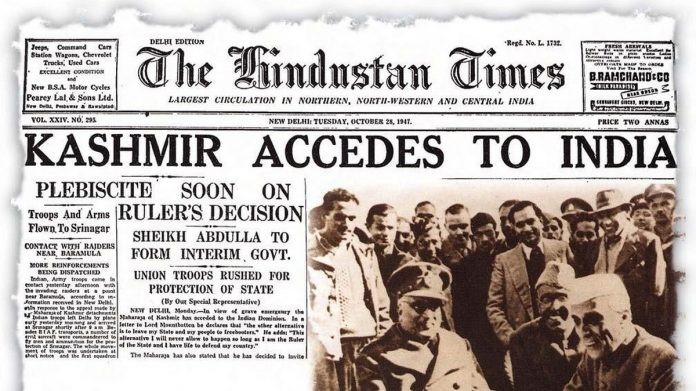
Source:
Image of the Day - Rare Owl
This is image of a rare Owl unseen for 150 years photographed in the wild for the first time. British scientists working in Ghana have rediscovered a ‘holy grail’ giant owl that has lurked almost unseen in African rainforests for 150 years. It is called as Shelley’s Eagle Owl. Shelley’s Eagle Owl is officially classified as vulnerable to extinction with an estimated population of a few thousand individuals. The bird was first described in 1872 from a specimen obtained from a local hunter in Ghana.

Source:
Climate change in Third Pole
- Context: The NASA Earth Observatory has recently released images of two lakes in the Tibetan Plateau that showed changes caused by the retreating glaciers.
- The climate crisis has been altering the geography of the Third Pole- the Tibetan plateau- which has been melting faster than any other part of the world.
- The two lakes namely Chibzhang Co and Dorsoidong Co were found to have grown larger between October 1987 and October 2021 with thinning and shrinking of the glaciers.
- The area of the lakes grew by 23% between 1976 and 2017 and the depth of the channel that connected the two main lobes of the lake increased by about 26 feet between 1990s and 2021.
- Glacial melting was found to be the major cause for the increase in the size of the lakes with other factors being amount of annual precipitation, rate of evaporation and permafrost during summer months.
- It was observed that even if global warming was kept to 1.5oC above the pre-industrialization levels, warming in the region will likely be at least 0.3oC higher.

Source:
Image Source:
India's largest Green Hydrogen Plant
- Context: Gas Authority of India Limited (GAIL) has planned to build India's largest green hydrogen-making plant.
- This plant aims to supplement GAIL’s natural gas business with carbon-free fuel.
- The plant planned is a 10MW electrolyser capable of generating 5 tonne of green hydrogen daily, the largest announced so far in the country.
- The hydrogen that is produced can be sold to fertilizer units which as per government mandate are required to use hydrogen as fuel.
- Hydrogen that plays an important role in meeting the world's energy needs can be produced in three different ways namely:
- Coal gasification (brown hydrogen)
- Deriving it from methane in natural gas (blue hydrogen) and
- Using renewable energy to produce green hydrogen.
- Green hydrogen is the cleanest of all with zero carbon emission.

Source:
- India's largest green hydrogen plant to be built by GAIL
- GAIL to build India's largest green hydrogen plant to supplement natural gas production
Image Source:
Sela Tunnel
- Context: The Sela Tunnel is being constructed at an altitude of 13,500 feet on a strategic road in Arunachal Pradesh will provide all-weather connectivity to
- The Sela Tunnel is a ₹700 crore worth tunnel constructed on the Balipara-Charduar-Tawang (BCT) road.
- It will be the longest bi-lane road tunnel in the world.
- It aims to provide better movement of troops and weaponry to various forward locations along the Line of Actual Control (LAC).
- The escape tunnel is 1.55 km in length in the Nuranang area between the Tawang and West Kameng districts which will cut down the distance to Tawang by six kilometres and the travel time by at least an hour.
- The twin tunnel is connected by an approach road with another tunnel 980 metres long.
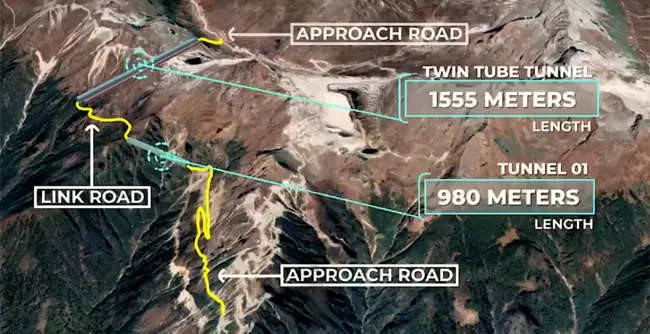
Source:
- Arunachal's Sela Tunnel to Ensure Better Troops, Weapon Movement: Army
- India’s strategic Sela Tunnel near China Border: All you need to know
Image Source:
Nurturing startups leveraging AI
- Context: Microsoft has launched a programme for nurturing and scaling startups that are leveraging artificial intelligence (AI).
- Microsoft AI Innovate is a 10-week initiative to support startups by scaling operations, driving innovation, and building industry expertise for turning their meaningful innovation into actionable results.
- It focuses on making AI accessible to everyone and enables startups to reach out to newer customers and geographies with Microsoft’s sales and partner networks.
- The selected startups in each of the cohorts will have access to industry deep-dive sessions and AI masterclasses by industry experts, mentoring by unicorn founders, skilling and certification opportunities.
- With the third-largest AI startup ecosystem in the world, AI adoption can add more than $90 billion to the Indian economy by 2025.

Source:
- Microsoft launches programme for nurturing, scaling startups leveraging AI
- Microsoft launches new initiative to empower AI startups in India
Image Source:
A festering crisis in the Palk Strait: TH
Essence: The article focuses its conversation on the humanitarian crisis involving unaccounted killing of Indian fishermen by Sri Lanka navy patrol in Palk Strait region. Tamil boats at times travel across the International Maritime Boundary Line (IMBL) into the Lankan territory and are met with hefty penalty, jail sentence and at times, lose their lives during tense encounter with Lankan navy.
The Indian fishing community is composed of the trawler owners who earn well due to the practice of bottom trawling and the poor fishermen who risk their lives to get a good catch. Bottom trawling has led to decrease in marine biodiversity at the sea-bed and is not considered a healthy practice. Efforts must be inclined towards ending fishing that is counterproductive to the marine ecosystem while ensuring that an accountable mechanism is drawn regarding incidental movement across IMBL.
Why you should read this article?
- To understand the pain of Indian and Lankan fishermen and apathy of the authorities towards them.
- To gain an insight into the ways to conduct responsible fishing.
- To understand the roles and performance of stakeholders in fisheries industry at Palk Strait.
Source:
Migrants keep India moving: TOI
Essence: The livelihood of migrants in India is not secure. In the recent times, there are instances of exodus of migrants for various reasons such as national lockdown, terror attacks in Kashmir, etc. Many states have also passed nativity laws, which is in violation of Article 19 of the Constitution of India. The interstate migrants suffer from prejudices and are often blamed for taking away jobs of locals, even for murders and rapes in cities. But states like Kerala, Gujarat, and Punjab do not discriminate against migrants as the people from these states too migrated all over India, and the world.
Due to increase in nativist movements and anti-migrant rhetoric in the recent times, it is time to consider an inter-state migration council on the lines of GST Council. This council can keep latest data on the migrants and oversee the effective implementation of schemes such as One Nation, One Ration Card.
Why you should read this article?
- To understand about the prejudices which interstate migrants are facing.
- To know why Bihar bears the brunt of anti-migration rhetoric and the reasons why certain states do not discriminate against migrants.
- To know about the need for inter-state migration council and the functions which it is expected to perform.
Source:
India’s productivity challenge is especially steep in-service sector: LM
Essence: The article raises the concerns regarding increasing the productivity of service workers which is one of the biggest challenges that India faces. Though important but it hasn’t yet received much attention. Important because low and medium productivity service sectors employ 70% of non-farm employment in India where there is still no proven method to raise productivity. With passage of time share of people in low productivity services had increased whereas in high productivity services had fallen.
Though the use of technology would help raise the productivity but it would be difficult to distribute the real value added per person between workers and capital owners. While low-productivity services will continue to employ the majority of the country’s workforce, there is no clear-cut policy path to improve the productivity of workers in these sectors.
Why you should read this article?
- To understand problem of improving the productivity of service sector workers.
- To understand the trends of workforce in different productivity sectors of the economy.
- To understand the need to research and develop mechanism to measure productivity of new types of jobs like gig jobs.
Source:
Gender Sensitive Work Places
Background
- As the society progresses, sensitisation about women health also has become an area to work upon.
- One of the food delivery companies, Swiggy has taken an initiative towards women welfare.

How is Swiggy setting standards for the working community?
- Swiggy has introduced a two-day paid monthly period time-off policy for all the regular female delivery partners
- For addressing the hesitancy, a no-questions-asked policy has been formulated to avail these leave.
- Swiggy has also partnered with Shell to provide female delivery partners access to restrooms across all their petrol stations in the country.
- A SOS-emergency support usage guidelines and important safety dos and don’t have been formulated for a safe working environment.
- It strives to provide better livelihood opportunities for lower-income workers, while creating a more inclusive workforce.
Quote:
“Communities and countries and ultimately the world are only as strong as the health of their women.” – Michelle Obama
Source:
Image Source:
Share the article
Get Latest Updates on Offers, Event dates, and free Mentorship sessions.

Get in touch with our Expert Academic Counsellors 👋
FAQs
UPSC Daily Current Affairs focuses on learning current events on a daily basis. An aspirant needs to study regular and updated information about current events, news, and relevant topics that are important for UPSC aspirants. It covers national and international affairs, government policies, socio-economic issues, science and technology advancements, and more.
UPSC Daily Current Affairs provides aspirants with a concise and comprehensive overview of the latest happenings and developments across various fields. It helps aspirants stay updated with current affairs and provides them with valuable insights and analysis, which are essential for answering questions in the UPSC examinations. It enhances their knowledge, analytical skills, and ability to connect current affairs with the UPSC syllabus.
UPSC Daily Current Affairs covers a wide range of topics, including politics, economics, science and technology, environment, social issues, governance, international relations, and more. It offers news summaries, in-depth analyses, editorials, opinion pieces, and relevant study materials. It also provides practice questions and quizzes to help aspirants test their understanding of current affairs.
Edukemy's UPSC Daily Current Affairs can be accessed through:
- UPSC Daily Current Affairs can be accessed through Current Affairs tab at the top of the Main Page of Edukemy.
- Edukemy Mobile app: The Daily Current Affairs can also be access through Edukemy Mobile App.
- Social media: Follow Edukemy’s official social media accounts or pages that provide UPSC Daily Current Affairs updates, including Facebook, Twitter, or Telegram channels.

